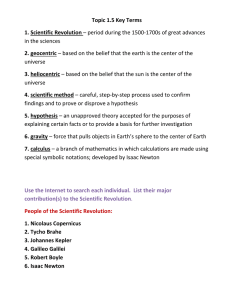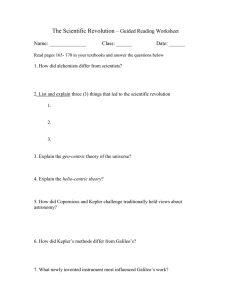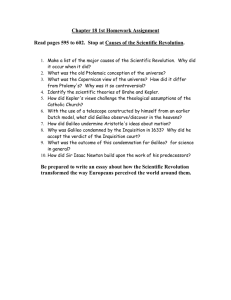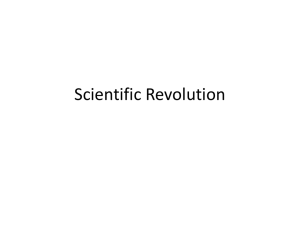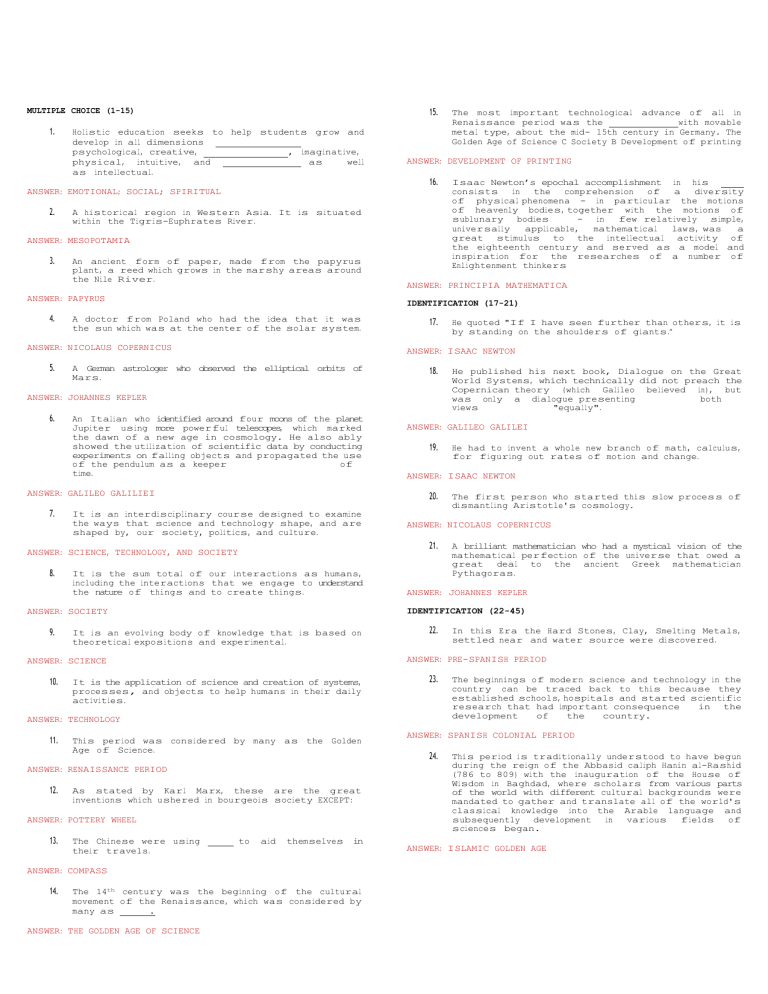
MIDTERM TOPICS UNIT 1 - 3 MULTIPLE CHOICE (1-15) 1. 15. Holistic education seeks to help students grow and develop in all dimensions psychological, creative, , imaginative, physical, intuitive, and as well as intellectual. ANSWER: DEVELOPMENT OF PRINTING 16. ANSWER: EMOTIONAL; SOCIAL; SPIRITUAL 2. A historical region in Western Asia. It is situated within the Tigris-Euphrates River. ANSWER: MESOPOTAMIA 3. An ancient form of paper, made from the papyrus plant, a reed which grows in the marshy areas around the Nile River. ANSWER: PAPYRUS 4. ANSWER: PRINCIPIA MATHEMATICA 17. A German astrologer who observed the elliptical orbits of Mars. An Italian who identified around four moons of the planet Jupiter using more powerful telescopes, which marked the dawn of a new age in cosmology. He also ably showed the utilization of scientific data by conducting experiments on falling objects and propagated the use of the pendulum as a keeper of time. ANSWER: GALILEO GALILIEI 7. 18. It is an interdisciplinary course designed to examine the ways that science and technology shape, and are shaped by, our society, politics, and culture. It is an evolving body of knowledge that is based on theoretical expositions and experimental. ANSWER: ISAAC NEWTON ANSWER: NICOLAUS COPERNICUS It is the application of science and creation of systems, processes, and objects to help humans in their daily activities. This period was considered by many as the Golden Age of Science. ANSWER: RENAISSANCE PERIOD 12. As stated by Karl Marx, these are the great inventions which ushered in bourgeois society EXCEPT: ANSWER: POTTERY WHEEL 13. The Chinese were using their travels. to aid themselves in ANSWER: COMPASS 14. The 14th century was the beginning of the cultural movement of the Renaissance, which was considered by many as . ANSWER: THE GOLDEN AGE OF SCIENCE A brilliant mathematician who had a mystical vision of the mathematical perfection of the universe that owed a great deal to the ancient Greek mathematician Pythagoras. ANSWER: JOHANNES KEPLER 22. 23. ANSWER: TECHNOLOGY 11. The first person who started this slow process of dismantling Aristotle's cosmology. In this Era the Hard Stones, Clay, Smelting Metals, settled near and water source were discovered. ANSWER: PRE-SPANISH PERIOD ANSWER: SCIENCE 10. He had to invent a whole new branch of math, calculus, for figuring out rates of motion and change. IDENTIFICATION (22-45) ANSWER: SOCIETY 9. 19. 21. It is the sum total of our interactions as humans, including the interactions that we engage to understand the nature of things and to create things. He published his next book, Dialogue on the Great World Systems, which technically did not preach the Copernican theory (which Galileo believed in), but was only a dialogue presenting both views "equally". ANSWER: GALILEO GALILEI 20. ANSWER: SCIENCE, TECHNOLOGY, AND SOCIETY 8. He quoted "If I have seen further than others, it is by standing on the shoulders of giants.” ANSWER: ISAAC NEWTON ANSWER: JOHANNES KEPLER 6. Isaac Newton’s epochal accomplishment in his consists in the comprehension of a diversity of physical phenomena - in particular the motions of heavenly bodies, together with the motions of sublunary bodies - in few relatively simple, universally applicable, mathematical laws, was a great stimulus to the intellectual activity of the eighteenth century and served as a model and inspiration for the researches of a number of Enlightenment thinkers IDENTIFICATION (17-21) A doctor from Poland who had the idea that it was the sun which was at the center of the solar system. ANSWER: NICOLAUS COPERNICUS 5. The most important technological advance of all in Renaissance period was the with movable metal type, about the mid- 15th century in Germany. The Golden Age of Science C Society B Development of printing The beginnings of modern science and technology in the country can be traced back to this because they established schools, hospitals and started scientific research that had important consequence in the development of the country. ANSWER: SPANISH COLONIAL PERIOD 24. This period is traditionally understood to have begun during the reign of the Abbasid caliph Hanin al-Rashid (786 to 809) with the inauguration of the House of Wisdom in Baghdad, where scholars from various parts of the world with different cultural backgrounds were mandated to gather and translate all of the world's classical knowledge into the Arable language and subsequently development in various fields of sciences began. ANSWER: ISLAMIC GOLDEN AGE MIDTERM TOPICS UNIT 1 - 3 25. This period was characterized by radical reorientation in science, which emphasized reason over superstition and science over blind faith. This period produced numerous books, essays, inventions, scientific discoveries, laws, wars and revolutions. Is a way of describing the blurring of boundaries between the physical, digital, and digital worlds. ANSWER: SCINECE AND TECHNOLOGY FOURTH INDUSTRIAL REVOLUTION 27. It was designed, developed and assembled by Filipino researchers and engineers the dance of Japanese experts. A satellite provides real-time, high-resolution and multi-color under infrared images for various applications, including meteorological imaging crop and ocean productivity measurement and high-resolution imaging of natural and man- made features. Is a framework containing all the commonly accepted views about a subject, conventions about what direction research should take and how it should be performed. 39. Is a period where paradigm shifts occurred and where scientific b e l i e f s that have been widely embraced and accepted by the people were challenged and opposed. 40. 30. The most influential figure in Western science until the 1600's, who created a body of scientific theory that towered like a colossus over Western Civilization for some 2000 years. ANSWER: ARISTOTLE 31. 41. A model of the universe in which the stationary Earth lies in the center and all other celestial objects orbit it. Most advanced Mesoamerican civilization. ANSWER: MAYA CIVILIZATION 34. Is responsible for formulating and adopting a comprehensive National Science and Technology plan to coordinate its funding and implementation. ANSWER: DEPARTMENT OF SCIENCE AND TECHNOLOGY / DOST 35. An environment-friendly and sustainable alternative light source that runs on saltwater. making it suitable to those who live in coastal areas. It can also function well in remote barrios. With just two tablespoons of salt and one glass of tap water, this ecologically designed lamp can run for eight hours. ANSWER: SALT LAMP 36. It is used to provide a warm environment for babies born prematurely or for other infants. ANSWER: BAMBOO INCUBATOR / INCUBATOR 43. A Filipina food technologist, pharmaceutical chemist, humanitarian, and a war heroine. ANSWER: MARIA Y. OROSA He was the first to successfully use math to define the workings of the cosmos. ANSWER: GEOCENTRIC MODEL 33. She is known as the mother of Philippine Pediatrics, a very great scientist and a symbol of female empowerment in medicine, both in the Philippines and abroad. The first Asian woman admitted into Harvard, she pursued graduate degrees in America after receiving her medical degree from the University of the Philippines. ANSWER: FE V. DEL MUNDO 44. ANSWER: GALILEO GALILEI 32. She graduated from De La Salle Lipa of Bachelor of Science in Computer Engineering in 2006. She worked as a database and automation engineer for 5 years. ANSWER: AISA MIJENO 42. ANSWER: INTELLECTUAL REVOLUTION Facilitates the acquisition of strategic and relevant technologies by Filipino companies for immediate incorporation in their R&D activities. ANSWER: BSIT ANSWER: SCIENTIFIC PARADIGM 29. Collaboration between researchers, scientists, and other research experts. Complements the establishment of R&D Centers through the NICER Program. ANSWER: CRADLE ANSWER: DIWATA-1 28. Capacitates Higher Education Institutions (HEIs) in the regions to make significant improvement in regional research. Provides institutional grants for HEIs in the regions for R&D capacity. ANSWER: NICER 38. ANSWER: ENLIGHTENMENT PERIOD 26. 37. He is a Filipino scientist, inventor and horticulturist who is known for his successful experiment on the inducement of flowering of mango trees by spraying them with ethrel and potassium nitrate. ANSWER: RAMON BARBA A period of change that describes current economic, social, and technological trends beyond the Industrial Revolution. ANSWER: INFROMATION REVOLUTION 45. A powdered preparation of soya-beans, which helped save the lives of thousands of Filipinos, Americans, and other nationals who ever held prisoners in different Japanese concentration camps during World War II. It became known to them as the "magic food.” ANSWER: SOYALAC

